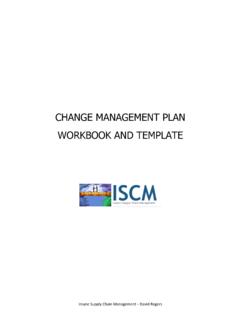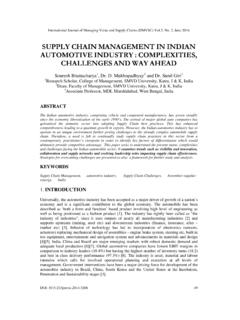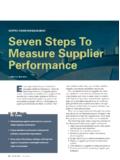Transcription of Overcoming Supply Chain Management …
1 Overcoming Supply Chain Management challenges in a Very High Mix, Low Volume and volatile demand manufacturing environment Applying Lean manufacturing Principles to Optimize the Supply Chain Case Study: Dr. Harpal Gill, PhD. Mark Lopus Kevin Camelon Synopsis Supply Chain Management challenges are unique in very high mix, low volume and volatile demand manufacturing environments compared to very high volume and low mix environments. More and more, manufacturers are confronted with this problem today. Traditionally, lean manufacturing practices are believed to be more suited for high volume, low mix manufacturing .
2 This is a myth. This papers shows that lean manufacturing practices have many benefits to offer in all manufacturing environments, regardless of the product mix and volume. The lack of proper education and training in an organization has been shown to be the biggest barrier to a successful lean manufacturing implementation. Lead time in different areas of the Supply Chain is a main cause of inefficiencies. Through proper training, encouragement and participation at all levels, excellent results in Supply Chain optimization in high-mix, low-volume manufacturing environments can be attained.
3 Value stream mapping has proven to be a very simple but extremely effective tool for identifying issues affecting the key metrics of a Supply Chain . This paper compares the Supply Chain challenges using two cases of manufacturing environments. It describes how the Supply Chain was optimized in terms of performance metrics with special emphasis on excess and obsolete (E/O) inventory and Lead Time (LT) reduction in the optical industry. The improvements in each of the metrics are shown to have a direct effect on the organization's Ship to Commit (STC) performance. The paper also describes the special tools developed to optimize different parts of the Supply Chain process and how some Lean manufacturing components particularly six sigma and Kaizen were deployed to optimize the Supply Chain metrics for a high-mix, low-volume manufacturing environment .
4 The results of each practice are included. -2- High Volume / Low Mix vs. Low Volume / High Mix: The Supply Chain Challenge All companies share the same end goals of on- demand order fulfillment and lower costs of goods sold. But the ability to realize gains from Supply Chain optimization is not the same among companies with different product mix and volume ratios. A high volume / low mix manufacturer producing consumer electronics for a broad global market has different leverage points within the Supply Chain than does a low volume / high mix manufacturer who builds specialized technology products for a narrower market.
5 When comparing Supply Chain metrics between these two types of manufacturing companies a huge contrast becomes readily evident as shown in Figure 1. Each metric is defined and measured on a scale of 1 to 5 in a metrics scorecard where rating of 5 is the optimal score relative to the industry. The criterion for the ratings is listed below in Table 1. Figure 1: Optics Supply Chain performance pales by comparison to that of an established consumer based industry like PC motherboards. Achieving A high volume / low mix comparable levels of excellence requires innovative implementations of lean manufacturer producing standard PC principles.
6 Motherboards, for example, can be expected to have relatively stable and predictable end-product demand . It will have a smaller Supply base providing many standard ship-to-stock components and materials. High volumes can be leveraged to reduce the ordering frequency and subsequently run a more efficient Supply Chain operation with high inventory turns and little exposure to excess and obsolete inventory. In contrast to the generally robust Supply Chain performance in the well established high volume / low mix businesses, the same is not true for the fiber optic components and subsystems manufacturers.
7 They operate in a very low volume / very high mix environment , facing constant demand volatility as product forecasts oscillate. This type of manufacturer relies on a large supplier base, each providing unique components for specialized products making the Supply base and internal operations Management unwieldy and exposure to excess and obsolete inventory a big challenge. For the low volume / high mix manufacturer, Supply Chain optimization requires innovative approaches to match the performance demonstrated in high volume / low mix environments. Supply Chain Performance Metrics Scorecard demand Churn Score Criteria 5 demand is steady with no churn within a long term fixed planning horizon demand fluctuates within the short term fixed planning horizon but is only 4 committed to the Master demand Schedule when there are no negative impacts to inventory, manufacturing capacity or delivery capability.
8 -3- A short term fixed planning horizon is defined where churn should not occur. Tools 3 are available to measure the impact of demand churn within the horizon. Churn is reduced and impact is assessed before being committed to the Master Schedule Visibility of forecast churn and sales order cancellation and reschedules exists. 2. Churn still occurs in the Master demand Schedule without control. No visibility of demand churn in the Master demand Schedule exists. No impact of 1 schedule changes can be assessed. Sales orders and forecasts are cancelled and rescheduled with no regard to delivery capability or inventory impact.
9 Inventory Score Criteria 5 There are little or no excess and obsolete inventories or shortages. Inventory turns are best in class for the industry. 4 Excess and Obsolete inventory is clearly predicted. Few shortages occur and they are well known in advance. Inventory turns are acceptable relative to the industry. 3 Excess and Obsolete inventory is regularly predicted and proactive actions to mitigate are taken. Material shortages are recognized and mitigated in advance. Inventory turns are marginal but improving relative to the industry. 2 Tools providing visibility of excess and obsolete inventory are in place.
10 Visibility of upcoming shortages is available. E/O inventory and shortages still occur. Inventory turns are low. 1 There is no visibility of excess and obsolete inventory. Shortages occur frequently without warning and seriously impact Ship to Commit. Inventory turns are very low. Delivery Performance Score Criteria 5 Ship to commit is 100%. 4 Planners make accurate delivery commitments. Missed commitments are rare. Ship to Commit performance is good (less than 90% - 95 %.) Delivery performance scores at the customers are approaching and meeting their required targets. 3 Tools are available to make better, more accurate delivery commitments.




